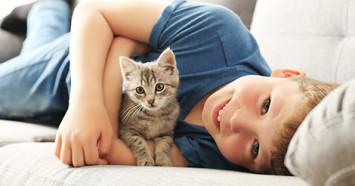
Unless they already have cats, at some point nearly every parent will hear their kids ask: “Can we get a cat?” Is the constant begging wearing you down? If you’re thinking about how to pick the best cat for your kids - don’t worry - we have some tips on how to help you find a kid-friendly cat and successfully introduce them to your baby, toddler, or child.
How to Pick the Best Cat for Your Kids
Sure, your instinct might be to take the kids down to the shelter and let them pick their cat. That might work in some cases, but I recommend you discuss your criteria before going. Or go on a kid-free trip to the facility to scout out the most appropriate cats and put a hold on one before bringing the kids up to meet them.
What criteria works for one family may not work for another. However, when you’re looking for a cat, consider if the following might be advantageous:
A cat who has been surrendered to the shelter with a history of living with and tolerating kids
An adult cat, instead of a kitten, who is less likely to play-bite or scratch
If you have several cats that meet any of these criteria, try interacting with the cat that is the most social in his kennel. If he’s soliciting affection from you, he is likely to be more interested in affectionate children.
If a cat has a history of bad behavior with children or seems reclusive and uncomfortable then they’re probably not the best match for the average kiddo.
What is the best breed of cat for kids?
If you’re doing searches for cats at catteries or through online rescue lists, you might have some luck narrowing your search down to a few breeds that are generally good with kids. Typically, laid-back and calm cats tend to be more tolerant of the noise and chaos that kids can bring, so consider that when picking a breed. A few suggestions:
Maine Coon: Often called gentle giants, these cats are not only huge, but also very social and laid back. Known to go with the flow, they’re intelligent and tolerate people and other animals quite well. Note: you’ll need to make sure this breed is brushed or groomed regularly due to their long, dense fur.
Ragdoll: These babies are super sweet and tend to go floppy when picked up, as their name would imply. They’re considered one of the most laid-back cat breeds and an all-around fit for families, but, like their Maine Coon friends, they do require regular brushing.
Sphynx: If brushing a cat every day (or at all) isn’t your thing, you’re in luck. The sphynx breed is commonly loving, social, and affectionate. That makes these wrinkly guys great pets, with no shedding to manage.
How to Introduce Your Kids to Cats
Before they even meet face-to-face, have a talk about the right, and wrong, way to touch a cat. First, the cat should be allowed to smell the child before ever being picked up. Teach the child about gentle petting, in a head-to-tail direction, and to avoid pinching or grabbing the fur, tail, whiskers, and ears. Have a toddler practice on a plush toy first so they get the hang of the motion. Explain to the child how a cat might not like loud sounds due to their stronger hearing abilities. Then set the ground rules such as never chasing a cat, always leave them alone while they’re eating, etc. Ultimately, it’s up to the adult to supervise and make sure both cat and kid are safe and acting respectfully.
Whether you’re introducing a baby, toddler, or a big kid to a cat, the main thing is to go slow. Make sure the cat can flee the scene and approach the child when they’re ready. If the cat seems nervous it may take a few days until they come out from behind the sofa and interact with their new family. Encourage your child to oversee feeding and watering the cat. This will help promote the bond and encourage the cat to trust the little human.
Growing up with cats can be a life-changing experience. It’s a wonderful opportunity to bond with a companion and set the building blocks for a love of animals. Finding the right cat for your child, and introducing them slowly, sets everyone up for a successful and meaningful relationship.